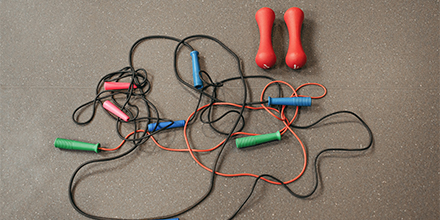Study shows physical education teachers influence students' attitudes about physical activity later in life

LAWRENCE — Everyone who has gone through high school probably remembers gym class, for better or worse, and the influence their teachers had on the class environment.
A study from the University of Kansas shows that physical education teachers greatly influence students’ perception of the class and its purpose and also influence how likely they are to remain physically active later in life.
Research has long shown that as students get older, their physical activity level drops. Thus, high school can be the last chance to encourage students to be physically active and encourage a healthy lifestyle.
The current study found that physical education teachers greatly influence how students perceive the class, its purpose and that the teachers’ style influences whether they enjoy physical activity. Thus, teachers should focus on providing a positive, fun experience in PE classes instead of simply having students compete or complete rote physical tasks, students indicated.
“My thing is always, ‘Let’s ask the students.’ We should be shaping physical education around what they want and need, along with what we want to be teaching content-wise to our students,” said Ken Murfay, assistant teaching professor of health, sport & exercise science at KU and lead author of the study. “The more we can give PE meaning for students, the better it will be long-term. Students want it to be both fun and meaningful.”
Study authors conducted focus group interviews with 25 students entering high school. The school was chosen because its primary physical education teacher had a reputation as an effective educator and students entered the school via a lottery system, ensuring a diverse cross section of participants. The results showed the students understood the purpose of physical education was to provide them a time to be physically active and teach them ways they could continue to have activity throughout their lives.
To that theme, the students indicated they preferred a variety of activities to an overemphasis on certain sports or to simply understand the rules or scoring of a particular sport, such as basketball.
Students also indicated they felt PE should be a fun experience to be meaningful. Those who reported enjoying the class also indicated the class had purpose and taught them ways to be active. Those who had negative experiences reported the class was simply a way to take up an hour of their school day or that they were instructed to move with little guidance or had an overemphasis placed on competition.
Perhaps the most significant theme was that students reported the influence the teacher had on their experience. A teacher’s style and the experiences they designed and provided largely shaped how students viewed the class, the sport or activity they were taking part in and their attitudes toward activity itself.
“Definitely a noticeable effect if you have a strict hardcore gym teacher who’s like, ‘You have to do this perfectly.’ It’s going to make the gym experience less enjoyable, and then you’re going to probably not really try to stay as active because now you have a negative experience in that field,” one student said. “You’re like, ‘I don’t really feel like doing this anymore.’ And especially in gym class when you have to be there for an hour and it’s required. You have no way out of it. You have a teacher that’s just yelling at you all day, like commands and stuff. It definitely changes the experience entirely.”
Murfay and colleagues examine physical education through social cognitive theory. The theory holds that human thoughts and actions are based on personal, behavioral and environmental factors. PE as taught in school is an environmental factor that can influence personal factors like self-efficacy. Teachers’ social persuasion through words and actions can also influence student perceptions of physical education and activity, and the curriculum they choose to implement — whether only team sports or a variety of activities — can shape how students view physical activity throughout life.
The study, published in the journal European Physical Education Review, was co-written with Aaron Beighle, Heather Erwin and Erin Aiello of the University of Kentucky.
Previous research has shown perceptions of PE are mixed, with negative attitudes increasing with age. A better understanding of the role teachers play in those perceptions can both help improve the experience for students at a crucial time in their lives and educations as well as encourage teachers to use more effective approaches. Results showing students prefer a fun, positively motivating experience with a variety of activity options can help encourage better PE curriculum, Murfay said.
A former K-8 physical education teacher, he said the goal of his research is to continually improve physical education, as studies have shown physical activity has a wide range of benefits throughout life, both physical and mental. As physical education can often be overlooked or its importance not fully understood, illustrating the importance of good PE teachers as crucial.
“How a teacher frames physical education is very important in how the student interprets it,” he said. “The environment a teacher creates affects how they view activity and sport in general, and perceptions are influenced by experience. If they get a teacher who is passionate and lets students control their physical activity, it can make a big difference.”
Image: Pexels.com